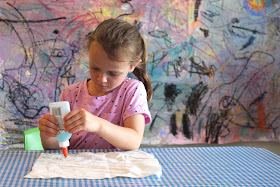It's quiet in the studio this week. We just spent 11 lively, festive, sometimes rambunctious but always- full- of -making weeks of summer camp with the studio brimming with curious creative kids. With all the bustling of summer camp, it's been a while since I have posted a project. This one is so good for all ages. We have done it with age 2 and done this project with teens and all in between. I will say that the glue is not as easy to get off as everyone says. We had to use palette knives to scrape and pull off the glue before washing the fabrics. It was hard work but lead for great conversation while working and the results are worth it. As many of you may know, I don't shy away from difficult projects. I really enjoy the challenge and also enjoy challenging my students.
Materials:
white fabric- we used cotton muslin bought from a fabric store but you could also use an old sheet or poplin
small bottles of glue- we have used both the gel and the washable white glue.
acrylic paint- desired colors watered down to the consistency of watercolor paint.
wooden stick- for hanging.
ribbon or thin fabric- for the tabs at the top to hang from branch
spray bottles
paint brush
Sometimes when doing this project we have the kids draw their idea on the fabric then following those lines with glue and sometimes we just give them the glue and let them draw with it. If you just give them the glue and let them go, many times it the kids start out slowly drawing but then they get the hang of it and just start splattering it around resulting in an abstract splatter affect.
We then let the glue dry overnight.
When the glue is dry we start to paint. We first give them spray bottles. By wetting the fabric first it allows the paint to be absorbed into the fabric a bit easier, than just sitting on the surface. The kids love using the spray bottles through out the painting of the fabric. It helps the paint to spread out.
Look at these vibrant colors.
We then let it dry again overnight to set the paint into the fabric.
If the glue design is simple, the glue is somewhat easy to peel but these artists designs were pretty intricate. The peeling process was a bit arduous so we resorted to using plastic palette knives. I do enjoy any opportunity to use tools. We also had to wet the fabric a bit again to soften the glue enough to scrape. This project was one problem solving opportunity after another. I would love to hear about your experience with this project if you have tried it before.
Once the glue was cleaned off and the fabric dried, we added small fabric tabs to the tops of the fabric so we could hang them from sticks. We used hot glue to fuse the fabrics tother quickly but you could also use regular glue or fabric glue. You would just have to wait until dry before hanging them on the sticks.
The results are spectacular.

























































